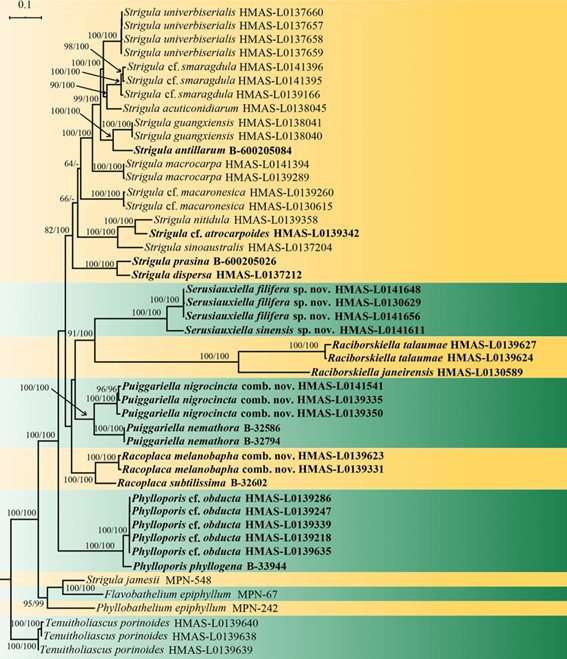Flavobathelium Lücking, Aptroot & Thor, Lichenologist 29: 221 (1997).
MycoBank number: MB 27825; Index Fungorum number: IF 27825; Facesoffungi number: FoF 08876; one morphologically and phylogenetically delimited species (Nelsen et al. 2011a).
Lichenized on leaves in terrestrial, lowland to lower montane tropical forests. Thallus thinly corticate, grey-green with characteristic metallic appearance. Photobiont Trentepohlia. Sexual morph: Ascomata perithecia, immersed in groups in slightly prominent pseudostromata covered by thallus layer and with a medulla containing ochraceous-yellow, K+ dark red, powdery crystals; individual perithecia ostiolate. Involucrellum absent. Excipulum prosoplectenchymatous, brown. Hamathecium comprising 1.5–2 µm wide paraphyses, hyaline, flexuose, unbranched to sparsely branched at the base. Asci 8-spored, bitunicate, fissitunicate, narrowly clavate to oblong-fusiform, shortly pedicellate, with narrow ocular chamber, non-amyloid. Ascospores irregularly arranged to biseriate, fusiform, hyaline, 3(–5)-septate, with thin eusepta and rectangular lumina, smooth-walled, not or slightly constricted at the septa. Asexual morph: Pycnidia common, immersed in groups in slightly prominent pseudostromata covered by thallus layer and with a medulla containing ochraceous-yellow, K+ dark red, powdery crystals; often whole thalli producing pycnidia only. Conidia acrogenous, only macroconidia known; macroconidia 3(–5)-septate, narrowly bacillar to acicular, distal end with a very narrow, ciliate appendage about one third as long as the conidia, proximal end with a short, gelatinous cap, hyaline.
Chemistry: Unidentified ochraceous-yellow anthraquinone crystals in ascomatal and pycnidial pseudostromata.
Type species: Flavobathelium epiphyllum Lücking et al., Lichenologist 29: 221 (1997).
Notes: Flavobathelium is thus far a monospecific, tropical genus growing on living leaves (Lücking et al. 1997; Lücking 2008). Given the inclusion of nonfoliicolous species with multi-septate to muriform ascospores and macroconidia in a single genus, Swinscowia (see below), one could theoretically consider Flavobathelium and Phyllobathelium conspecific. However, the two genera are not directly related phylogenetically, with Flavobathelium sister to Swinscowia and Phyllobathelium sister to the clade including the two other genera, with strong support (Fig. 70). This also sup- ports the separation of Swinscowia from Phyllocratera and may indicate that Swinscowia as here circumscribed is still heterogeneous, requiring assessment of some of the genuinely muriform-spored species currently included in the latter genus.

Fig. 70 Best scoring maximum-likelihood tree (also including Bayesian posterior probabilities) of Strigulaceae showing the currently recog- nized and sequenced genera (adapted from Jiang et al. 2020b; see that reference for further details)
Species
